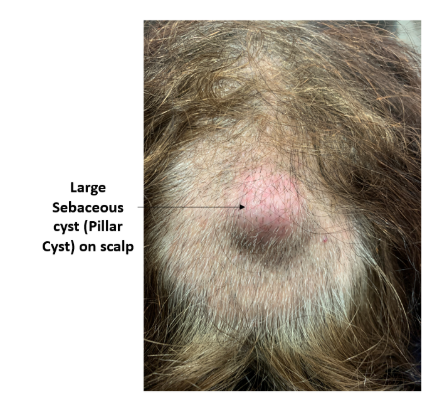What is an Epidermal Inclusion Cyst (Sebaceous Cyst- Pillar cyst)
An epidermal inclusion cyst often miscalled a “sebaceous cyst,” is a fluid-filled sac under the skin containing keratin and cell debris. It appears as a round lump or bump and is commonly seen on the face, chest, scalp, neck, back, or genital area. These cysts are benign and rarely harmful, but they can become inflamed, infected, or cosmetically unappealing.
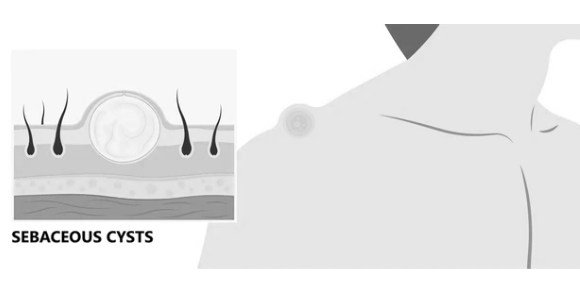
How to Identify and Diagnose a Sebaceous Cyst
- Appearance: Dome-shaped lump with a possible dark central dot (punctum).
- Symptoms: Typically painless but may become tender, swollen, or itchy if inflamed or infected.
- Size: Ranges from small (.25 inches) to larger than 2 inches.
- Diagnostic Methods:
- Physical examination.
- Imaging (e.g., ultrasound or CT scan) for larger cysts.
- Punch biopsy to confirm diagnosis if needed.
Symptoms and Causes
Symptoms:
- Visible Lump: A noticeable bump on the skin.
- Tenderness: Especially if inflamed or infected.
- Discoloration: The skin over the cyst may appear pink, red, or darker than the surrounding area.
- Drainage: Ruptured cysts may leak thick, yellowish material with a bad odor.
Causes:
- Blocked hair follicles.
- Skin trauma or injuries.
- Conditions like acne, chronic sun damage, or genetic syndromes.
Common Locations:
- Face, neck, scalp, chest, back, arms, legs, and genitalia.
Risk Factors:
- Ages 20–60 (rare in children).
- More common in individuals assigned male at birth (AMAB).
- Skin injuries or chronic conditions.
- Rare genetic disorders (e.g., Gardner syndrome, Gorlin syndrome).
Diagnosis of Epidermal Inclusion Cysts at MACS Clinic
At MACS Clinic, a diagnosis begins with a thorough clinical examination by Mr. Shailesh Vadodaria, our senior consultant plastic surgeon.
Diagnostic Process:
- Physical Examination: Most cysts are diagnosed visually and through palpation.
- Imaging (if necessary):
- Ultrasound: Determines the cyst’s size and content and to exclude any other rare diagnosis e.g. congenital conditions dermoid cyst known to have deeper extension ( head and neck region ) Parotid gland tumour needs excluded before surgical removal of sebaceous cyst in the cheek area.
- CT Scan: Helps confirm the diagnosis for larger cysts and guides treatment planning.
- Biopsy: A punch biopsy may be performed to rule out malignancy, especially if the cyst grows rapidly, is unusually large (>5 cm), or exhibits other concerning features.
Treatment Options at MACS Clinic
Treatment is personalized based on the cyst’s size, location, symptoms, and patient preference.
Non-Surgical Options:
- Observation: If asymptomatic, the cyst may be monitored without intervention.
- Home Care
- Over-the-counter pain relievers for mild discomfort.
- Antibiotics: Treat infected cysts.
Surgical Options:
For definitive treatment, surgical removal is the most effective option.
1. Incision and Drainage (I&D):
A small cut is made to release the keratin and fluid inside the cyst. This method provides temporary relief but does not remove the cyst capsule, leading to recurrence.
2. Surgical Excision (Recommended):
- A minimally invasive procedure performed under local anaesthesia.
- The entire cyst, including its capsule, is removed to prevent recurrence.
- The incision is carefully sutured to minimize scarring.
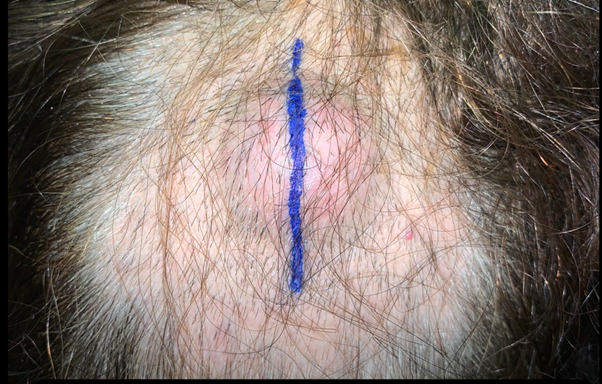
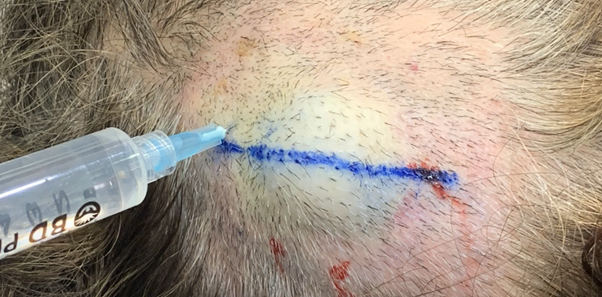
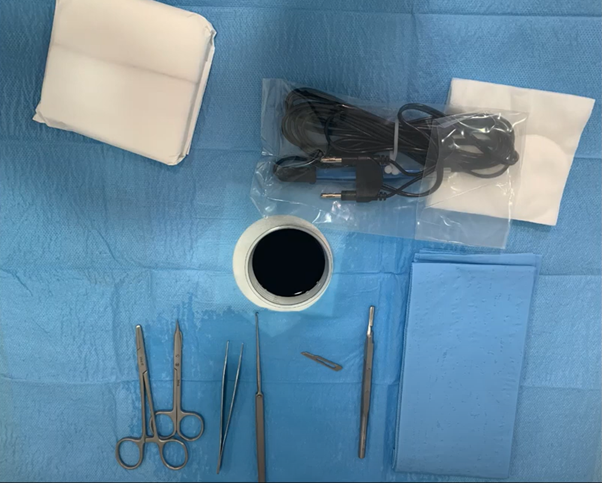
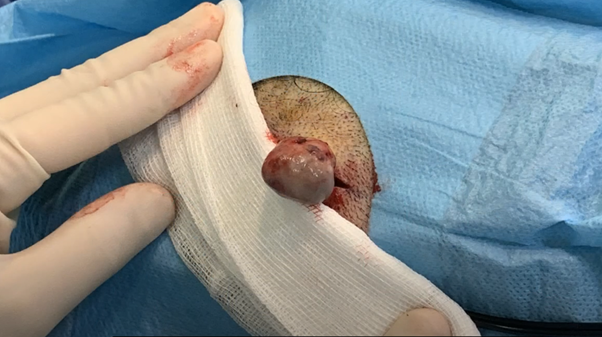
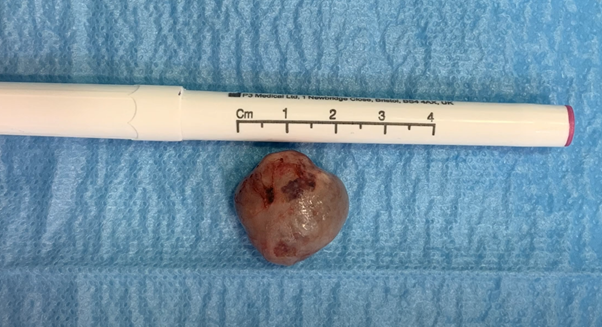
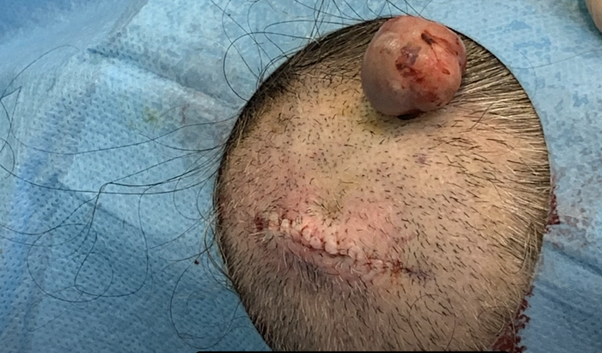
Management of Sebaceous Cyst at MACS Clinic
- Steps for Booking a Consultation with Mr. Shailesh Vadodaria at MACS Clinic
You can reach out to our clinic using any of the following methods:
- Phone: Call the clinic directly at 020 7078 4378.
- WhatsApp: Send a message to 07792 648 726
- Email: Contact the clinic at enquiries@macsclinic.co.uk.
- Online Contact Form: Visit the clinic’s website and fill out the contact form with your details – macsclinic.co.uk/contact-us
When contacting the clinic, ensure you include your complete name, preferred method of contact(email/phone/WhatsApp) and mention the specific procedure you are interested in, such as Sebaceous Cyst excision.
- Scheduling Your Consultation
After receiving your inquiry, a member of the MACS Clinic staff will reach out to you to schedule your consultation. You will be offered the option of a complimentary/free video consultation or an in-person consultation at the clinic, depending on your preference.
Before your consultation, our clinic team will provide you with a detailed information factsheet about the procedure you are interested in, such as Sebaceous Cyst excision. This document will give you an overview of the procedure, helping you to understand what to expect during and after the surgery.
During your consultation with Mr. Shailesh Vadodaria, our senior consultant plastic surgeon, he will explain all aspects of the Sebaceous Cyst excision procedure, including the surgical process, potential risks, complications, and expected outcomes. Detailed post-operative care instructions will be discussed to ensure a smooth recovery.
Mr. Vadodaria will also share representative before-and-after photos or videos of previous patients who have undergone Sebaceous Cyst excision, helping you visualize the potential results.
- Cost of the Sebaceous Cyst excision procedure
Following the consultation, the MACS Clinic team will send you a detailed cost estimate. This estimate will include all potential expenses associated with your procedure, allowing you to plan accordingly.
Cost depends upon size, number, anatomical location of Sebaceous Cyst and type of anaesthesia:
Cost estimate range: £500 – £2500
The final cost estimate will be provided after your consultation with Mr. Vadodaria. MACS Clinic provides services for patients insured with WPA, CIGNA, Vitality, BUPA, AVIVA and BUPA International. Consultation (video and/or face to face) for non-insured patient is complimentary (free).
- Technique used by Mr. Vadodaria for the surgical excision of Sebaceous Cyst
Mr. Shailesh Vadodaria performs the excision of Sebaceous Cyst under local, sedation or general anaesthesia as a day case procedure. This procedure involves making a precise incision over the Sebaceous Cyst and carefully removing it. This procedure requires around 30 – 45 minutes.
- What to Expect on the Day of Your Sebaceous Cyst Excision at MACS Clinic?
Before your surgery begins, you will complete the consent process. This is an important step to ensure you fully understand the treatment, including its potential risks and benefits. Mr. Shailesh Vadodaria and his team will be available to answer any last-minute questions you may have. In compliance with National Government Law, all female patients of childbearing age will be required to take a pregnancy test on the day of the surgery. This is a standard precaution to ensure your safety during the procedure.
Mr. Vadodaria typically performs Sebaceous Cyst excision under local anaesthesia. This means you will be awake, but the area will be numbed, allowing you to remain comfortable and pain-free during the procedure. After the procedure, you will be provided with prescriptions for painkillers and antibiotics to manage any discomfort and prevent infection. These may be in tablet or ointment form. You will receive a comprehensive post-operative care information leaflet.
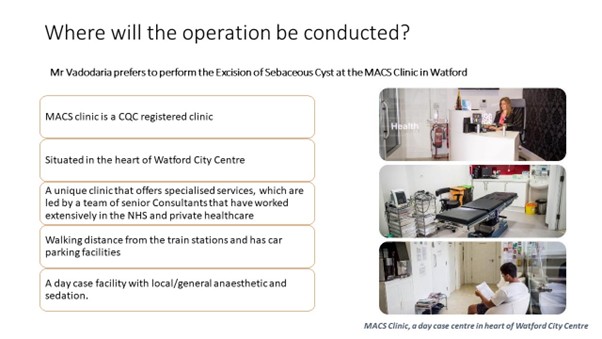
6. What post-operative care you need to take after the Sebaceous Cyst excision procedure at MACS Clinic?
a) For the first 24-48 hours, keep the surgical site clean and dry. After this period, you may gently clean the area with mild soap and water.
b) Keep the dressing in place as instructed. Typically, Mr. Vadodaria removes after a few days.
c) Avoid strenuous activities, heavy lifting, or exercise for at least a week or as advised by your surgeon. Excessive movement can increase the risk of bleeding, swelling, and delayed healing.
d) Watch for signs of infection such as increased redness, swelling, warmth, pus, or an unusual odour from the incision site. Fever or chills could also indicate an infection.
e) Some swelling and bruising are normal and should resolve within a few days. Applying a cold compress can help reduce swelling in the initial 24-48 hours.
f) Protect the incision site from direct sun exposure, as UV rays can darken the scar and make it more noticeable.
g) Once the wound has fully healed, Mr. Vadodaria may recommend using a silicone-based scar cream or gel to minimize the appearance of the scar.
7. Follow-Up with Mr. Shailesh Vadodaria
Our staff will schedule follow-up appointments with Mr. Shailesh Vadodaria at 1 week and 6 weeks after the procedure.
Risks and Complications of Sebaceous Cyst Excision procedure at MACS Clinic
While complications are rare, they may include:
- Minor scarring (reduced with proper wound care).
- Infection (managed with antibiotics).
- Bleeding or hematoma formation.
- Recurrence (minimized with complete capsule removal).
- Incomplete removal
- Revisional surgery
Why Choose MACS Clinic?
- Experienced Consultants: Receive care from Mr. Shailesh Vadodaria, a senior consultant plastic surgeon with years of experience in managing skin conditions.
- Patient-Centric Approach: Each treatment plan is tailored to individual needs.
- Advanced Techniques: Minimally invasive methods ensure optimal results with minimal downtime.
- Comprehensive Aftercare: Full support through recovery for the best outcome.
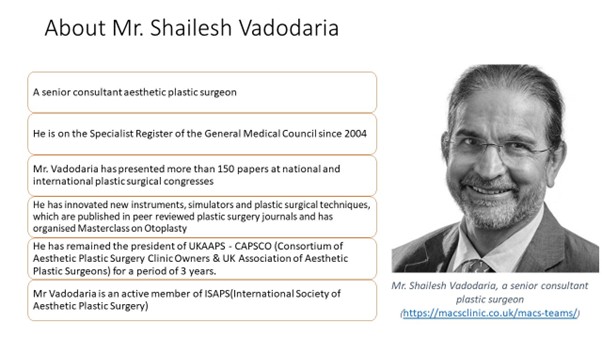
Frequently Asked Questions
- Will the cyst go away on its own?
Most cysts do not resolve without treatment. While some may remain small and asymptomatic, others can grow or become inflamed. - Is the procedure painful?
No, the procedure is performed under local anaesthesia, ensuring you remain comfortable throughout. - Will the cyst return after removal?
If the entire cyst and capsule are removed, recurrence is rare. - What happens if I leave a cyst untreated?
Untreated cysts may remain unchanged or grow over time. Complications like infection, rupture, or discomfort can occur in some cases.
Contact MACS Clinic
- Phone: 020 7078 4378
- WhatsApp: 07792 648 726
- Email: enquiries@macsclinic.co.uk
- Website: macsclinic.co.uk
- BOOK a FREE Video Consultation: https://calendly.com/macsclinic/free-video-consultation?month=2025-01

